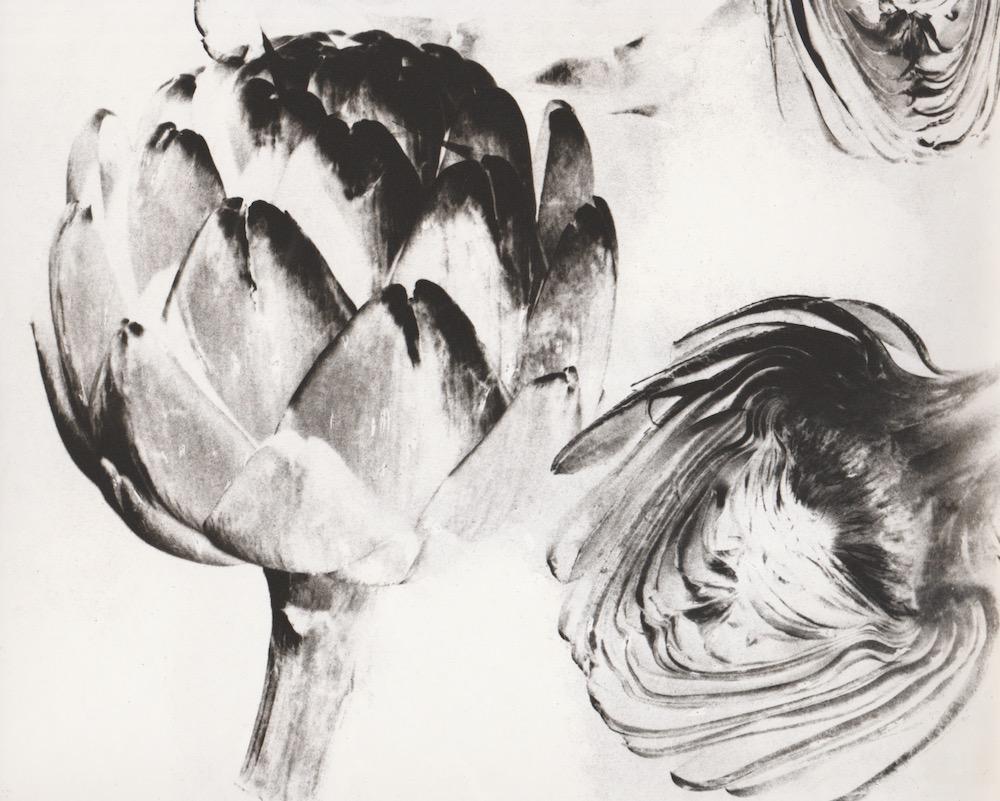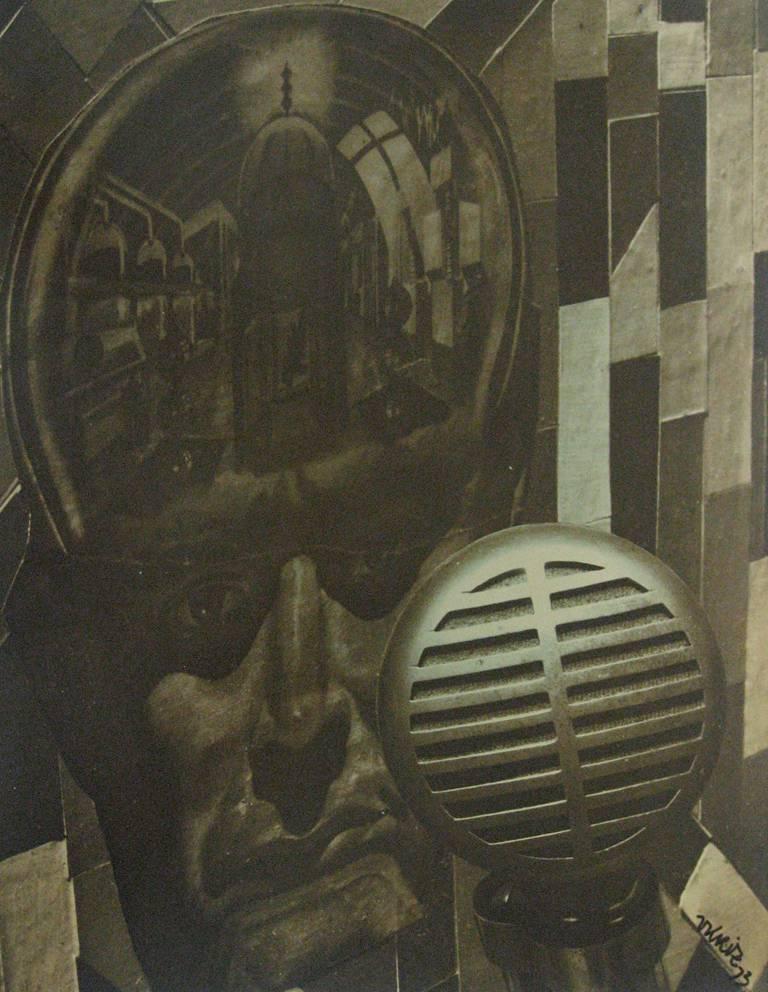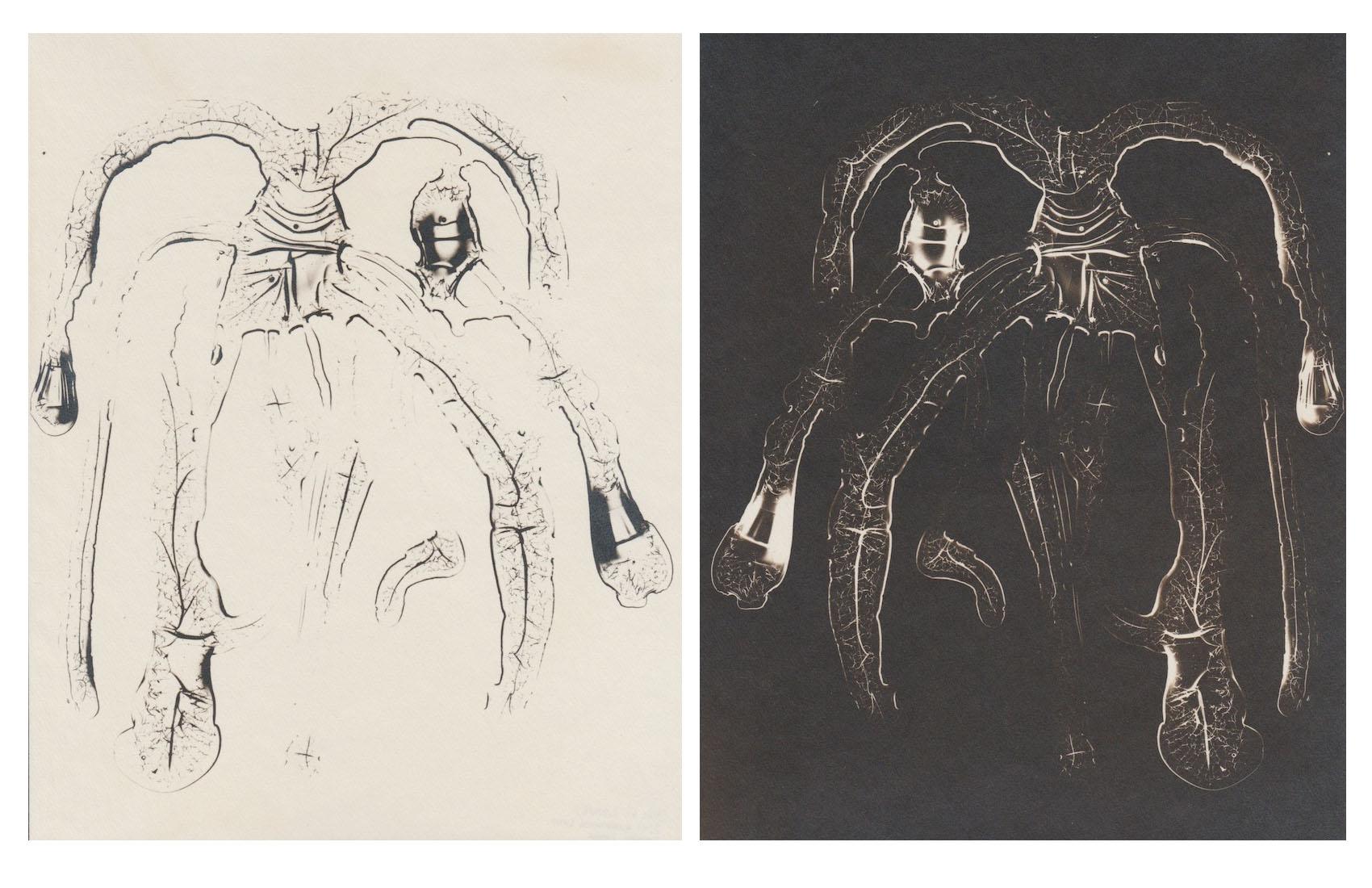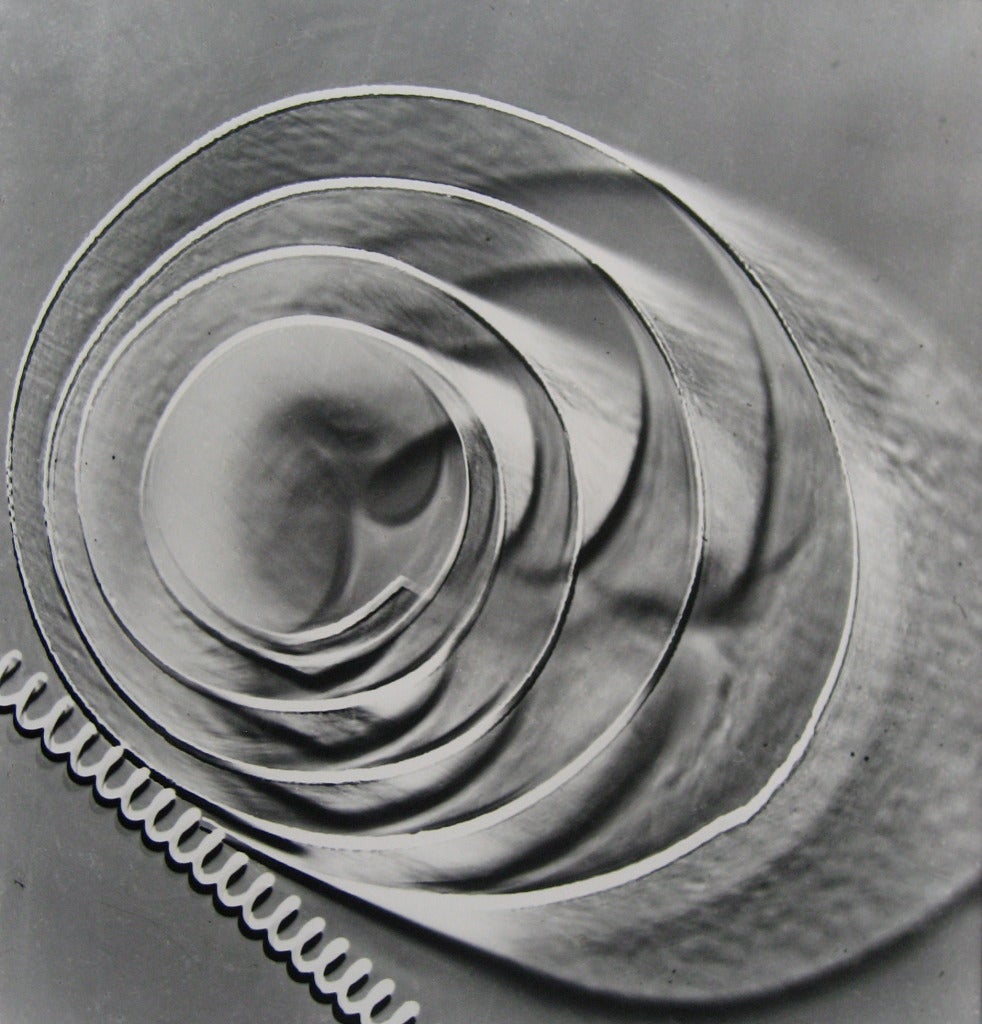Items Similar to Morocco 93 by Aaron Siskind, 1982, Photogravure
Video Loading
Want more images or videos?
Request additional images or videos from the seller
1 of 10
Aaron SiskindMorocco 93 by Aaron Siskind, 1982, Photogravure1982
1982
About the Item
Morocco 93 by Aaron Siskind presents an abstract image, a close up of a textured rock slab. Small dark square holes scatter across the rock. The subject is cropped, emphasizing the textures of the material.
Morocco 93 by Aaron Siskind is listed as 15.75 x 15.75 inch photogravure print, and is edition 39/50. This print is titled and dated with edition number and estate stamp on print verso. This print was printed by Clary Nelson and came from Renaissance Press.
Born in New York City, Aaron Siskind graduated from the City College of New York in 1926 and taught high school English until he became interested in photography in 1930. In 1933 he joined the Film and Photo League in New York, a group of documentary photographers devoted to improving social conditions in contemporary society through their pictures. While involved with the League, Siskind made some of his most successful and well-known documentary photographs, including those for The Harlem Document (1937-40), but he had a falling out with the organization in 1941. At the time, his work was assuming a new, more abstract focus, as evident in Tabernacle City, a series of photographs depicting the vernacular architecture of Bucks County, Pennsylvania. When his exhibition of this series at the Photo League caused many members to protest his photography outright, he left the organization and found support among Mark Rothko, Franz Kline, and other painters, who recognized his elimination of pictorial space and his concentration on the arrangement of objects within the picture plane as qualities aligning his work with their own. Siskind's photographs have been widely exhibited and he won many awards for his photography, including a Guggenheim Fellowship, and the Distinguished Photography Award from the Friends of Photography. Siskind was a photography instructor at Chicago's Institute of Design and served as head of the department there from 1961 to 1971.
Siskind's abstract photographs from the late 1940s and early 1950s were a major force in the development of avant-garde art in America. In rejecting the third dimension, this work belied the notion that photography was tied exclusively to representation. As such, Siskind's work served as an invaluable link between the American documentary movement of the 1930s and the more introspective photography that emerged in the 1950s and 60s.
- Creator:Aaron Siskind (1903-1991, American)
- Creation Year:1982
- Dimensions:Height: 15.75 in (40.01 cm)Width: 15.75 in (40.01 cm)Depth: 0.01 in (0.26 mm)
- Medium:
- Movement & Style:
- Period:
- Condition:
- Gallery Location:Dallas, TX
- Reference Number:
About the Seller
4.9
Recognized Seller
These prestigious sellers are industry leaders and represent the highest echelon for item quality and design.
Gold Seller
These expertly vetted sellers are highly rated and consistently exceed customer expectations.
Established in 1995
1stDibs seller since 2013
302 sales on 1stDibs
Typical response time: 1 hour
- ShippingRetrieving quote...Ships From: Dallas, TX
- Return PolicyA return for this item may be initiated within 7 days of delivery.
More From This SellerView All
- Untitled (artichokes) by Ida Lansky, ca. 1950, Vintage Silver Gelatin PrintBy Ida LanskyLocated in Dallas, TXUntitled (artichokes) by Ida G. Lansky features a detail shot of whole and cut up artichokes. The tones of this photograph are reversed, creating an abstract image from a common object. The produce is lit dramatically from the side, emphasizing it's intricate details. Untitled (artichokes) by Ida G. Lansky is an 8 x 10 inch vintage silver gelatin print. This photograph includes the artist's stamp in black ink on print verso. Ida G. Lansky was born in 1910 in Toronto, Canada. She pursued many careers in her lifetime including Nursing, Art, and Library Science. In 1928 she moved to New York City and later attended New York University, The Jewish Hospital in Brooklyn, NY and Cornell University. In 1942 she received a B.S. in Public Health Nursing. Ida Lansky moved to Hawaii in 1945 and married Irving Lansky. She then moved to Nor- man, Oklahoma and then to Denton, Texas where she studied art and was mother to two children, Ellen and Michele. From 1954 - 1959 she was in the Visual Art studies program at Texas Women’s University in Denton with an emphasis on photography. She studied under Carlotta Corpron...Category
1950s Modern Black and White Photography
MaterialsSilver Gelatin
- Untitled from "Sirague City"By Vilem KrizLocated in Dallas, TXSigned and dated in ink on image. Dated and stamped on verso. 13 1/2 x 10 1/2 inches. Toned gelatin silver print.Category
1970s Modern Black and White Photography
MaterialsSilver Gelatin
- Untitled Abstraction Reverse #1 and #2By Ida LanskyLocated in Dallas, TXTwo photographs each 10 x 8 in., vintage gelatin silver prints by Ida Lansky. Artist stamp on prints' verso. Ida G. Lansky was born in 1910 in Toronto, Canada. She pursued many careers in her lifetime including Nursing, Art, and Library Science. In 1928 she moved to New York City and later attended New York University, The Jewish Hospital in Brooklyn, NY and Cornell University. In 1942 she received a B.S. in Public Health Nursing. Ida Lansky moved to Hawaii in 1945 and married Irving Lansky. She then moved to Norman, Oklahoma and then to Denton, Texas where she studied art and was mother to two children, Ellen and Michele. From 1954 - 1959 she was in the Visual Art studies program at Texas Women’s University in Denton with an emphasis on photography. She studied under Carlotta Corpron. 1959 marked a peak in her art career when she exhibited her photographs in a group exhibition curated by Henry Holmes...Category
20th Century Modern Black and White Photography
MaterialsSilver Gelatin
- Fotogramma No. 7By Luigi VeronesiLocated in Dallas, TXEdition of 30 Signed, dated and numbered. Gelatin silver print, 9 x 11 1/8 in. Printed 1977Category
20th Century Modern Abstract Photography
MaterialsSilver Gelatin
- Fotogramma no. 56 & no. 57By Luigi VeronesiLocated in Dallas, TXEdition of 30 Signed, dated, and numbered. Both prints price at $5,000Category
20th Century Modern Abstract Photography
MaterialsSilver Gelatin
- Fotogramma No. 33By Luigi VeronesiLocated in Dallas, TXEdition of 30 Signed, dated and numbered.Category
20th Century Modern Abstract Photography
MaterialsSilver Gelatin
You May Also Like
- Architectural Gelatin SIlver Print Vellum Photograph Mark Citret Vintage PhotoBy Mark CitretLocated in Surfside, FLMark Citret, American, b. 1949. "Third Story Arches", Fort Point, 1998 Silver gelatin print hand signed and editioned 1/45 in pencil along lower edge. Published: "Along the Way" Mark...Category
1990s American Modern Black and White Photography
MaterialsVellum, Silver Gelatin
- Vintage Abstract Expressionist Hyman Bloom Photo Collage Assemblage PhotographBy Martin SumersLocated in Surfside, FLThis is a unique original collage, decoupage style of Jiri Kolar, This is an exceptional artwork which was part of a collaboration between Hyman Bloom and fellow artist and his very good friend Martin Sumers. This is pencil signed by Martin Sumers. Provenance: Acquired from the Sumers estate collection. Hyman Bloom (March 29, 1913 – August 26, 2009) was a Latvian-born American painter. His work was influenced by his Jewish heritage and Eastern religions as well as by artists including Altdorfer, Grünewald, Caravaggio, Rembrandt, Blake, Bresdin, James Ensor and Chaim Soutine. He first came to prominence when his work was included in the 1942 Museum of Modern Art exhibition "Americans 1942 -- 18 Artists from 9 States". MoMA purchased 2 paintings from the exhibition and Time magazine singled him out as a "striking discovery" in their exhibition review. His work was selected for both the 1948 and 1950 Venice Biennale exhibitions and his 1954 retrospective traveled from Boston's Institute of Contemporary Art to the Albright Gallery and the de Young Museum before closing out at The Whitney Museum of American Art in 1955. In a 1954 interview with Yale art professor Bernard Chaet, Willem de Kooning indicated that he and Jackson Pollock both considered Bloom to be “America’s first abstract expressionist”, a label that Bloom would disavow. Starting in the mid 1950s his work began to shift more towards works on paper and he exclusively focused on drawing throughout the 1960s, returning to painting in 1971. He continued both drawing and painting until his death in 2009 at the age of 9 Hyman Bloom (né Melamed) was born into an orthodox Jewish family in the tiny Jewish village of Brunavišķi in what is now Latvia, then part of the Russian Empire At a young age Bloom planned to become a rabbi, but his family could not find a suitable teacher. In the eighth grade he received a scholarship to a program for gifted high school students at the Museum of Fine Arts. He attended the Boston High School of Commerce, which was near the museum. He also took art classes at the West End Community Center, a settlement house. The classes were taught by Harold Zimmerman, a student at the School of the Museum of Fine Arts, who also taught the young Jack Levine at another settlement house in Roxbury. When Bloom was fifteen, he and Levine began studying with a well-known Harvard art professor, Denman Ross, who rented a studio for the purpose and paid the boys a weekly stipend to enable them to continue their studies rather than take jobs to support their families. He took Bloom and Levine on a field trip to the Museum of Modern Art in New York, where Bloom was impressed by the work of Rouault and Soutine and began experimenting with their expressive painting styles. In the 1930s Bloom worked sporadically for the Public Works of Art Project and the Federal Art Project (WPA), He shared a studio in the South End with Levine and another artist, Betty Chase. It was during this period that he developed a lifelong interest in Eastern philosophy and music, and in Theosophy. He first received national attention in 1942 when thirteen of his paintings were included in the Museum of Modern Art (MoMA) exhibition Americans 1942: 18 Artists from 9 States, curated by Dorothy Miller. MoMA purchased two of his paintings from that exhibition, and he was featured in Time magazine. The titles of his paintings in the exhibition reflect some of his recurring themes. Two were titled The Synagogue, another, Jew with the Torah; Bloom was actually criticized by one reviewer for including "stereotypical" Jewish images. He also had two paintings titled The Christmas Tree, and another titled The Chandelier, both subjects he returned to repeatedly. Another, Skeleton (c. 1936), was followed by a series of cadaver paintings in the forties, and The Fish (c. 1936) was one of many paintings and drawings of fish he created over the course of his career. Bloom was associated at first with the growing Abstract Expressionist movement. Willem de Kooning and Jackson Pollock, who first saw Bloom's work at the MoMA exhibition, considered Bloom "the first Abstract Expressionist artist in America." In 1950 he was chosen, along with the likes of de Kooning, Pollock, and Arshile Gorky, to represent the United States at the Venice Biennale. That same year Elaine de Kooning wrote about Bloom in ARTnews, noting that in paintings such as The Harpies, his work approached total abstraction: "the whole impact is carried in the boiling action of the pigment". In 1951 Thomas B. Hess reproduced Bloom's Archaeological Treasure in his first book, Abstract Painting: Background and American Phase, along with works by Picasso, Pollock, and others. Both de Kooning and Hess remarked on Bloom's expressive paint handling, a key characteristic of Abstract Expressionist painting. As abstract expressionism dominated the American art world, Bloom became disenchanted with it, calling it "emotional catharsis, with no intellectual basis." In addition, instead of moving to New York to pursue his career, he opted to stay in Boston. As a result he fell out of favor with critics and never achieved the kind of fame that Pollock and others did. He disliked self-promotion and never placed much value on critical acclaim. Many of Bloom's paintings feature rabbis, usually holding the Torah. According to Bloom, his intentions were more artistic than religious. He began questioning his Jewish faith early in life, and painted rabbis, he claimed, because that was what he knew. Over the course of his career he produced dozens of paintings of rabbis...Category
1990s Modern Abstract Photography
MaterialsPaper, Photographic Paper
- Vintage Silver Gelatin Photograph Jacques Lipchitz Sculpture Photo SignedBy Marc VauxLocated in Surfside, FLMarc Vaux, a figure of Montparnasse, produced a trove of photographs which are currently held in the collection of the Centre Pompidou in Paris, France. Marc Vaux was committed equally to supporting artists, notably by creating the Foyer des Artistes (1946-70) and, in 1951, the first Musée du Montparnasse at 10, rue de l’Arrivée. Marc Vaux was born on February 19, 1895 in Crulai, Normandy Thanks to the color merchant from whom he bought his plates and his photographic equipment, he met the sculptor Charles Desvergnes winner of Prix the Rome and author of various memorials who was looking for someone to photographs his works. Two of Marc Vaux’s first clients were his neighbors of 21 Avenue du Maine- Marie Vassilieff and Maria Blanchard who introduced him to Parisian avant-garde artists: Juan Gris, André Lhote, Jacques Lipchitz, Ortiz de Zarate...Category
1930s Modern Abstract Photography
MaterialsPhotographic Paper, Silver Gelatin
- Vintage Silver Gelatin Photograph Jacques Lipchitz Bronze Sculpture Photo SignedBy Marc VauxLocated in Surfside, FLMarc Vaux, a figure of Montparnasse, produced a trove of photographs which are currently held in the collection of the Centre Pompidou in Paris, France. Marc Vaux was committed equally to supporting artists, notably by creating the Foyer des Artistes (1946-70) and, in 1951, the first Musée du Montparnasse at 10, rue de l’Arrivée. Marc Vaux was born on February 19, 1895 in Crulai, Normandy Thanks to the color merchant from whom he bought his plates and his photographic equipment, he met the sculptor Charles Desvergnes winner of Prix the Rome and author of various memorials who was looking for someone to photographs his works. Two of Marc Vaux’s first clients were his neighbors of 21 Avenue du Maine- Marie Vassilieff and Maria Blanchard who introduced him to Parisian avant-garde artists: Juan Gris, André Lhote, Jacques Lipchitz, Ortiz de Zarate...Category
1930s Modern Abstract Photography
MaterialsSilver Gelatin, Photographic Paper
- Vintage Silver Gelatin Photograph Jacques Lipchitz Bronze Sculpture Photo SignedBy Marc VauxLocated in Surfside, FLMarc Vaux, a figure of Montparnasse, produced a trove of photographs which are currently held in the collection of the Centre Pompidou in Paris, France. Marc Vaux was committed...Category
1920s Modern Abstract Photography
MaterialsPhotographic Paper, Silver Gelatin
- Vintage Silver Gelatin Photograph Jacques Lipchitz Sculpture Photo SignedBy Marc VauxLocated in Surfside, FLMarc Vaux, a figure of Montparnasse, produced a trove of photographs which are currently held in the collection of the Centre Pompidou in Paris, France. Marc Vaux was committed equally to supporting artists, notably by creating the Foyer des Artistes (1946-70) and, in 1951, the first Musée du Montparnasse at 10, rue de l’Arrivée. Marc Vaux was born on February 19, 1895 in Crulai, Normandy Thanks to the color merchant from whom he bought his plates and his photographic equipment, he met the sculptor Charles Desvergnes winner of Prix the Rome and author of various memorials who was looking for someone to photographs his works. Two of Marc Vaux’s first clients were his neighbors of 21 Avenue du Maine- Marie Vassilieff and Maria Blanchard who introduced him to Parisian avant-garde artists: Juan Gris, André Lhote, Jacques Lipchitz, Ortiz de Zarate...Category
1930s Modern Abstract Photography
MaterialsPhotographic Paper, Silver Gelatin
Recently Viewed
View AllMore Ways To Browse
Among The Stones
Milady Beautiful
20 X 36
David Marshall Photo
Robert Blankshine
Karol Brown
Audrey Hepburn Telephone
John Prine
Reflection De Cartier Ring
Margaret Rice
Print Photo Of Jean Michel Basquiat
Hermes Bag Street Style
Hermes Birkin 30 Street Style
Hermes Birkin Street Style
James Craig Ship
James Stoddart
Lauren Bacall Photos Vintage
Lorenzo Jack Nicholson





